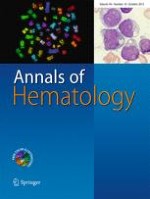Published in:

01-10-2015 | Original Article
Body mass index as a prognostic factor in Asian patients treated with chemoimmunotherapy for diffuse large B cell lymphoma, not otherwise specified
Authors:
Hee Sang Hwang, Dok Hyun Yoon, Cheolwon Suh, Jooryung Huh
Published in:
Annals of Hematology
|
Issue 10/2015
Login to get access
Abstract
Obesity was recently reported to confer a survival advantage in diffuse large B cell lymphoma (DLBCL) among Western populations. Given ethnic differences, previous studies recommended a revision of the WHO classification of obesity for Asians. We investigated the prognostic impact of body mass index (BMI) using modified WHO criteria in a retrospective cohort of 562 Korean patients with DLBCL. Patients were categorized into five groups according to BMI: 26 (4.6 %) as underweight (<18.5 kg/m2), 230 (40.9 %) as normal weight (18.5–22.9 kg/m2), 129 (23.0 %) as overweight (23.0–24.9 kg/m2), 160 (28.5 %) as obese (25.0–29.9 kg/m2), and 17 (3.0 %) as severely obese (≥30 kg/m2). As BMI increased, the relative hazard ratio (HR) decreased sharply, reaching the lowest value in the overweight group, and then rose again in the obese and severely obese. On univariate analysis, both overall survival (OS) and progression-free survival (PFS) were best in the overweight group, followed by normal > obese > severely obese > underweight groups. Multivariate analysis showed a significantly shorter survival in the underweight (OS: HR 2.90, 95 % confidence interval (CI) 1.35–6.19, P = 0.006; PFS: HR 3.08, 95 % CI 1.55–6.09, P = 0.001) and severely obese groups (OS: HR 2.93, 95 % CI 1.08–7.95, P = 0.035; PFS: HR 2.59, 95 % CI 1.06–6.36, P = 0.038). We show that being underweight or, contrary to findings in Western patients, being severely obese has a deleterious prognostic impact in DLBCL in Koreans. Revising the BMI criterion that defines obesity according to the patient’s ethnic differences could therefore better delineate DLBCL risk groups in Asian patients.